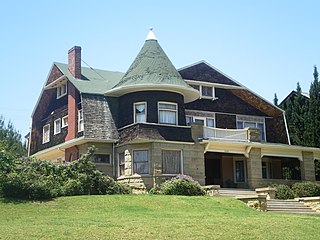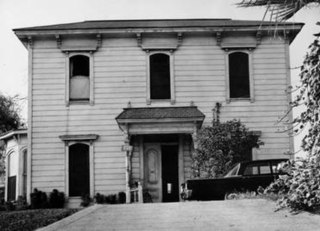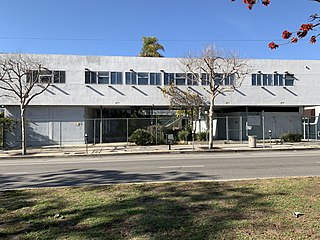
Los Angeles Historic-Cultural Monuments are sites which have been designated by the Los Angeles, California, Cultural Heritage Commission as worthy of preservation based on architectural, historic and cultural criteria.

Los Angeles Historic-Cultural Monuments are sites which have been designated by the Los Angeles, California, Cultural Heritage Commission as worthy of preservation based on architectural, historic and cultural criteria.
The Historic-Cultural Monument process has its origin in the Historic Buildings Committee formed in 1958 by the Los Angeles chapter of the American Institute of Architects. As growth and development in Los Angeles threatened the city's historic landmarks, the committee sought to implement a formal preservation program in cooperation with local civic, cultural and business organizations and municipal leaders. On April 30, 1962, a historic preservation ordinance proposed by the AIA committee was passed.
The original Cultural Heritage Board (later renamed a commission) was formed in the summer of 1962, consisting of William Woollett, FAIA, Bonnie H. Riedel, Carl S. Dentzel, Senaida Sullivan and Edith Gibbs Vaughan. [1]
The board met for the first time in August 1962, at a time when the owner of the historic Leonis Adobe was attempting to demolish the structure and replace it with a supermarket. In its first day of official business, the board designated the Leonis Adobe and four other sites as Historic-Cultural Monuments. [1] [2]
In the commission's first decade of operation (August 1962–August 1972), it designated 101 properties as Historic-Cultural Monuments. By April 2018, there were over 1150 designated properties. [3]
The designation of a property as a Historic-Cultural Monument does not prevent demolition or alteration. However, the designation requires permits for demolition or substantial alteration to be presented to the commission. [4] The commission has the power to delay the demolition of a designated property for up to one year.
| HCM # [5] | Landmark name [3] | Image | Date designated [3] | Locality [3] | Area | Description [6] |
|---|---|---|---|---|---|---|
| 160 | Manzanar |  | September 15, 1976 | Highway 395 36°43′42″N118°9′16″W / 36.72833°N 118.15444°W | Inyo County, California | Japanese American internment site, World War II. Located at the foot of the Sierra Nevada in the Owens Valley. Land was owned by the Los Angeles Department of Water and Power when the US Government leased it for the Manzanar concentration camp. |

The Drum Barracks, also known as Camp Drum and the Drum Barracks Civil War Museum, is the last remaining original American Civil War era military facility in the Los Angeles area. Located in the Wilmington, Los Angeles, California, United States, near the Port of Los Angeles, it has been designated as a California Historic Landmark, a Los Angeles Historic Cultural Monument. It has been listed on the National Register of Historic Places. Since 1987, it has been operated as a Civil War museum that is open to the public.

Wilshire Park is a neighborhood in the Central Los Angeles region of Los Angeles, California.

The Leonis Adobe is a historic adobe located in what is now Calabasas, California. One of the oldest surviving private residences in Los Angeles County and one of the oldest surviving buildings in the San Fernando Valley, it was built in 1844 and occupied by the wealthy rancher Miguel Leonis until his death. Afterward, the property was the subject of a legal dispute between his common law wife Espiritu Chijulla, heirs, and a daughter born out of wedlock; the dispute lasted more than 15 years in the courts. In 1961, the adobe had fallen victim to vandalism, and its owner applied for a permit to raze the structure and erect a supermarket in its place. Preservationists succeeded in having the adobe declared Los Angeles Historic-Cultural Monument #1 in 1962, saving it from the wrecking ball at the last minute. It was listed on the National Register of Historic Places in 1975.

Rómulo Pico Adobe, also known as Ranchito Rómulo and Andrés Pico Adobe, was built in 1834 and is the oldest residence in the San Fernando Valley, making it the second oldest residence in Los Angeles. Built and owned by the Pico family of California, a prominent Californio family, the adobe is located in the Mission Hills section of the city and is a short distance from the San Fernando Mission. It was listed on the National Register of Historic Places in 1966.

Alvarado Terrace Historic District is a designated historic district in the Pico-Union district of Los Angeles, California. It is located southwest of Downtown Los Angeles, along Alvarado Terrace between Pico Boulevard and Alvarado Street.

Chateau Colline is an historic eight-unit apartment building on Wilshire Boulevard in the Westwood section of Los Angeles, California.

Shadow Ranch is a historic ranch house, built from 1869-1872 using adobe and redwood lumber, on the original Workman Ranch in the western San Fernando Valley of Los Angeles, California. For much of the 20th century it was in Canoga Park, but it is now within the boundaries of the West Hills community.

The Salt Box was a house built in the early 1880s in the Bunker Hill section of Los Angeles, California. Designed in the saltbox style that was popularized in New England, it was originally located at 339 South Bunker Hill Avenue. It was the home of physician Dr. A.G. Cook for most of the 1880s. In the late 19th century, Bunker Hill was one of the most prestigious neighborhoods in Los Angeles and was the site of many elegant Victorian homes. The Los Angeles Times wrote of old Bunker Hill: "Nowhere else in Los Angeles was the architecture so ornate. The mansions were wooden-frame Victorian with Gothic gingerbread touches applied with a heavy hand to simulate masonry." Though not as elegant as many of its Victorian neighbors, the Salt Box was "cherished by architecture students for the simplicity of its design."

The Barry Building is a landmark commercial mid-twentieth century modern building located at 11973 San Vicente Boulevard in the heart of the Brentwood neighborhood of Los Angeles, California. It was designed by architect Milton Caughey (1911-1958) and completed in 1951. In 2007, the building was listed as a Los Angeles Historic-Cultural Monument,(Historical Cultural Monument #887), making it one of the few mid-century modern commercial buildings to gain such status. It was identified by the Los Angeles Cultural Heritage Commission as being a well-preserved and notable example of the California-style modern design. Despite this designation, the building's current owners received permission to demolish the building in 2019. As of March 2021, the building has not yet been demolished, however it is currently boarded up and vacant.
Landmarks officially designated by local city or county governments in the United States.

The Glendale Register of Historic Resources and Historic Districts consist of buildings, structures, bridges, statues, trees, and other objects designated by the City of Glendale, California, as significant historic resources or historic districts.